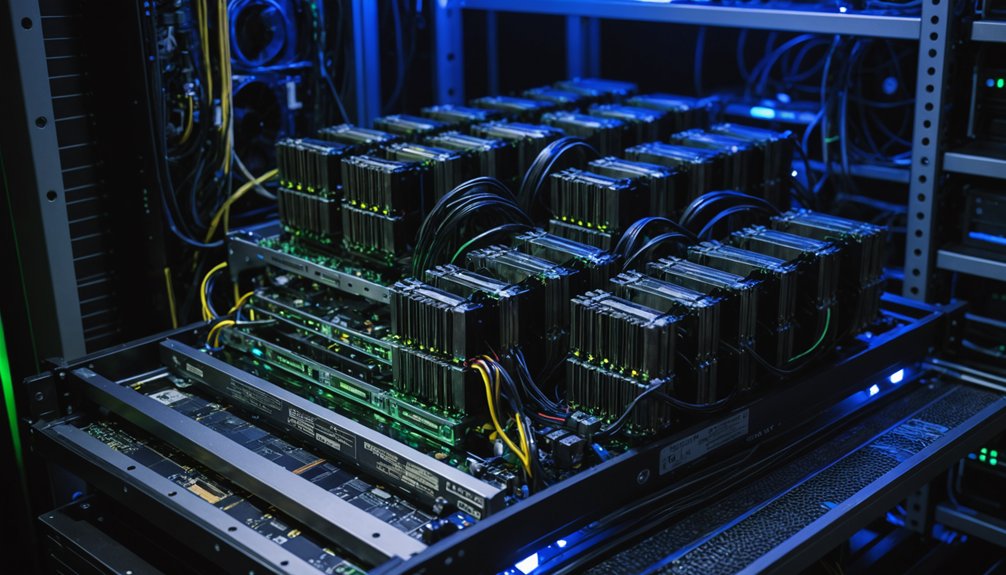Scaling machine learning systems demands more than just adding servers. Effective scaling integrates centralized feature stores for reusable data processing and high-performance computing resources like GPUs. Data management isn't optional—it's essential. Z-score standardization and proper preprocessing prevent garbage-in-garbage-out scenarios. Multi-GPU setups accelerate training while Bayesian methods optimize hyperparameters without the guesswork. Security can't be an afterthought either. The most successful systems balance infrastructure, code, and data harmoniously.

Taming the beast of machine learning at scale isn't for the faint-hearted. Systems buckle under massive datasets, complex models devour computing resources, and without proper architecture, everything grinds to a halt.
Let's face it—scaling ML isn't just adding more servers. It's a delicate dance of infrastructure, code, and data management that separates the pros from the amateurs.
Centralized feature stores have revolutionized how teams handle ML features. They're not just fancy databases; they're the backbone of scalable systems. Store features once, use them everywhere. Revolutionary, right?
These repositories maintain both offline batch processing capabilities and online real-time access. Historical data stays intact, giving models the context they need to perform accurately over time. Feature stores facilitate collaboration across teams by standardizing feature engineering practices.
High-performance computing isn't optional anymore. It's survival. Languages like C++ and Java outperform Python for raw number-crunching. GPUs and TPUs? They're not luxury items—they're necessities for serious ML work.
Distributed frameworks like Hadoop and Spark handle terabytes of data without breaking a sweat. And here's a dirty little secret: horizontal scaling across multiple machines often beats throwing money at bigger servers.
Data management makes or breaks ML systems. Period. Efficient collection, preprocessing, and storage determine whether models learn or just spin their wheels. Implementing Z-score standardization ensures all features contribute equally to model performance. Data preparation is a critical step that can significantly impact the model's final performance.
Data parallelism—splitting data across nodes—accelerates training dramatically. But security can't be an afterthought. One breach, and your cutting-edge ML system becomes tomorrow's cautionary tale.
Training strategies matter more than most realize. Multi-GPU setups and robust evaluation metrics guarantee models actually learn what they should. Automatic retraining keeps models fresh when faced with data drift.
And hyperparameter tuning? Bayesian methods find ideal settings without exhausting computing budgets.
The truth is harsh but simple: scaling ML systems requires orchestrating multiple disciplines simultaneously. It's not rocket science—it's harder.
Scaling ML isn't just engineering—it's a symphony of technical disciplines playing in perfect harmony.
But with centralized features, high-performance computing, robust data management, and smart training approaches, it's doable. Not easy, but doable.
The machine learning process encompasses several phases from domain understanding to evaluation, with the modeling phase requiring particularly careful scaling considerations when dealing with massive datasets like ImageNet.
Frequently Asked Questions
How Do ML Scaling Costs Compare to Traditional Software Systems?
ML systems cost way more to scale than traditional software.
They need massive upfront investments for data, specialized talent, and serious computing power.
Traditional software? Cheaper to start with.
ML's computational requirements are through the roof – all that number-crunching isn't free.
But here's the kicker: ML might pay off better long-term once models improve.
Short-term pain, potential long-term gain.
The trade-off is real.
What Security Vulnerabilities Emerge When Scaling ML Systems?
Scaling ML systems opens a Pandora's box of security headaches.
Bigger datasets? More data breach risks.
Complex infrastructure? Expanded attack surfaces.
Dependencies multiply, each one a potential ticking bomb.
Model extraction gets easier.
Adversaries have more points to inject poisoned data.
Supply chain attacks become nightmares.
And don't forget – larger models mean extracting private training data becomes disturbingly feasible.
It's a security minefield, honestly.
When Should Organizations Avoid Scaling Their ML Models?
Organizations should avoid scaling ML models when costs outweigh benefits—plain and simple.
No clear ROI? Don't bother.
Technical infrastructure matters too; weak hardware or nonexistent MLOps capabilities will tank the effort.
Models that overfit or become black boxes? Useless.
Sometimes companies get caught up in the "bigger is better" hype.
Regulatory headaches and security risks might not be worth it.
Small can be beautiful, folks.
How Does Model Interpretability Change at Scale?
Model interpretability gets complicated at scale. Period. Larger models become black boxes – harder to decipher what's happening inside.
Global explanations offer bird's-eye views while local ones explain individual predictions. Techniques like SHAP and LIME help, but they're not perfect.
Interpretability tools struggle to keep pace with growing model complexity. Visualization tools help, sure, but the tradeoff is real. More parameters, less transparency. That's just how it is.
What Legal Implications Arise From Scaling ML Internationally?
Scaling ML internationally? Legal headache central.
Different countries, different rules. GDPR in Europe demands data protection while the CCPA rules California.
Cross-border data transfers get messy, fast. Intellectual property rights vary wildly across jurisdictions.
Some nations have strict AI regulations, others barely any. Companies face a patchwork of cybersecurity standards too.
Want global ML deployment? Better have lawyers on speed dial.




